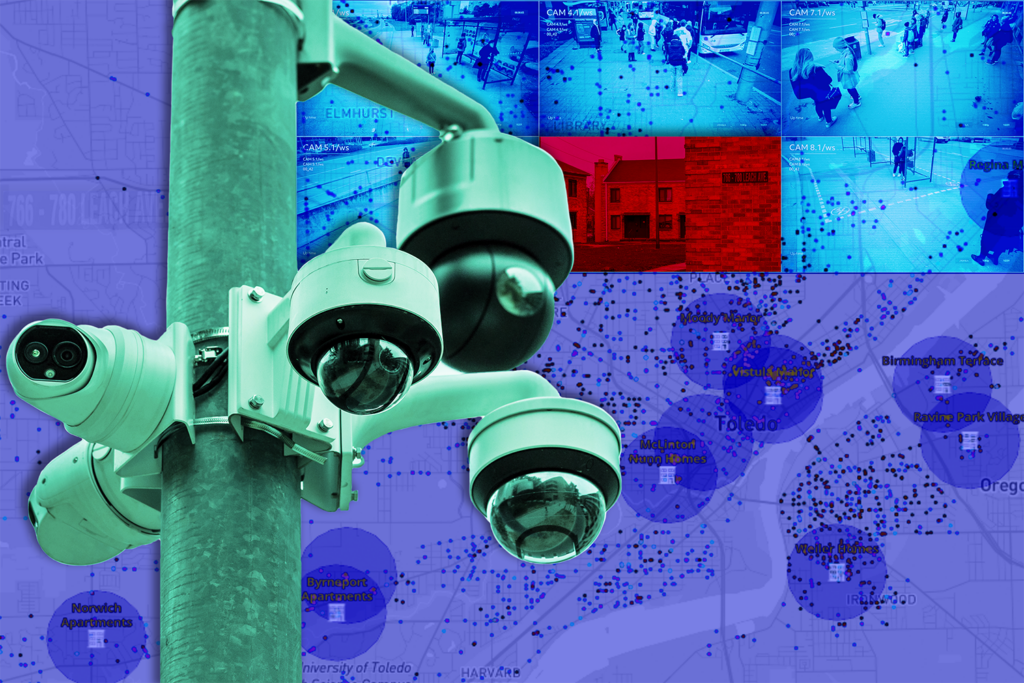Reporting from Toledo, Ohio — For more than seven straight hours on January 24, 2024, a Toledo cop watched the comings and goings on Leach Avenue.
Officer Gerald Glesmer didn’t need to park his cruiser outside the brown brick apartments of the Weiler Homes public housing complex or walk past the patios and grassy lawns dotted with kids’ bicycles. A constant live stream of the street was pumped straight to police headquarters from four surveillance cameras.
Glesmer surveilled the community from 4:50 p.m. until just after midnight the next morning. After a short break, he began cycling through the cameras again until officer Valerie Lewis took over the watch around 4 a.m. She kept Leach Avenue camera streams running constantly until 10:45 a.m. During that time, there were no reports of a crime on Leach Avenue or anywhere else in the Weiler Homes complex, according to police data.
This kind of surveillance has become the norm in Toledo, where living in subsidized housing now means being watched outside your home day and night by an officer you can’t see or speak to, thanks to the city’s contract with Fusus, a company whose controversial technology enables cops to access live streams from private camera networks that opt in to the system.
Between January 1 and October 8 of 2024, Toledo police spent a cumulative 3,822 hours, the equivalent of 159 days, watching live streams from 23 Fusus-enabled cameras at Weiler Homes, according to software audit log data Gizmodo obtained through a public records request, which shows each time a TPD employee accessed feeds through Fusus.
A similar story played out in subsidized housing across the city: Officers spent 18,751 hours streaming live camera feeds from 275 cameras at 12 apartment complexes owned by the Lucas Metropolitan Housing Authority (LMHA) and several private landlords. That was twice as much time as they spent watching the other 439 Fusus-enabled cameras spread throughout Toledo combined.
“This data really illustrates the risks associated with this type of surveillance,” said Beryl Lipton, a senior investigative researcher with the Electronic Frontier Foundation. “The idea that people who are already in a vulnerable space in their housing development are subject to increased levels of surveillance simply because that is where they live really highlights how inequitable and unjust these applications of surveillance can be.”
More than 80% of public housing tenants and housing voucher recipients in Toledo are not white, according to the most recent data from the Department of Housing and Urban Development.
Toledo police did not directly answer Gizmodo’s questions about why officers accessed Fusus live streams from subsidized housing complexes so much more than those from other locations. “Camera feeds may be open in the crime center for ease of use and to limit technical issues while accessing said feeds,” TPD public information officer Prince Flores wrote in response to questions. “These numerous feeds can be opened simultaneously and can also lead to documented view time, even though not monitored at that time.”
Residents of Toledo’s subsidized housing developments told Gizmodo that they want to feel protected from crime, but knowing that TPD officers can secretly watch them outside their apartments 24/7 isn’t necessarily reassuring.
“I feel safe, but I don’t feel safe at the same time,” said Jihad Henley, who is Black and lives in the privately owned Greenbelt Place Apartments. “Me being the person I am and my skin color, I might be a statistic. If [police] come by, they might mistake me for someone else”
Elijah Fitch, who lives in Weiler Homes, said that even after Toledo police began using Fusus last summer, their response to crimes in the community has been slow. “it really doesn’t matter” if they can watch live streams, he said. “They gon’ take their sweet time to get out here anyway.”
The disproportionate surveillance of low-income Toledoens through Fusus isn’t simply the result of a data-driven analysis of where crimes occur most.
During the period Gizmodo examined, only 20% of the city’s crime occurred within half a mile—a wide buffer zone—of one of the 12 housing complexes, according to police data on homicides, shootings, aggravated assaults, robberies, thefts from vehicles, and car thefts. But 66% of the time a Toledo officer streamed a live feed through Fusus, the camera was at one of the 12 developments.
The increased police attention can threaten low-income renters’ freedom and access to housing, said Kristie Ortiz, managing attorney for the Toledo-based legal services nonprofit Advocates for Basic Legal Equality. Researchers argue that “hypersurveillance” of subsidized communities helps create a “public-housing-to-prison pipeline.” And reporting has shown that housing authorities and private landlords often use surveillance footage of minor rule violations and reports of crimes to evict tenants, even if they don’t lead to convictions.
“It is surprising to see that their focus is just on housing authorities and affordable housing,” Ortiz said of TPD’s use of the Fusus system. “It’s clearly discrimination on some level.”
Surveillance Without a Crime
Fusus, which has spread to at least 150 jurisdictions, was fully acquired for $241 million in 2024 by the police tech giant Axon, which made its name selling Tasers but has expanded its product line to include the core software systems that many police departments use to manage their surveillance and evidence logs.
Axon did not respond to Gizmodo’s request for comment.
In addition to receiving unprecedented access to private camera feeds, Fusus’s police customers can integrate other tools—such as automated license plate readers, drones, and object recognition algorithms—into the cloud-based platform, allowing them to follow people as they move through an entire region or watch who comes and goes from a particular address over the course of months. In most jurisdictions, that kind of surveillance doesn’t require a warrant or any evidence that a crime has been committed at all.
At a press conference in 2023, during which Toledo’s mayor and police officials announced the rollout of the Fusus system, local reporters questioned whether it would be an invasion of residents’ privacy. In response, one of the city’s top cops said the department would only tap into live streams from private cameras in cases of bonafide emergencies.
“We are not watching them on a regular basis … by policy, [officers] are not to look at those business cameras unless an emergency or call comes in,” Lt. Jeffrey Thieman, who oversees TPD’s criminal intelligence section, said during the press conference.
The audit log data Gizmodo obtained for Toledo’s Fusus system, however, shows officers frequently tap into cameras at housing complexes for long stretches of time when no crime is reported.
Take the playgrounds at the McClinton Nunn Homes, where thousand-dollar camera systems watch over swing sets that don’t have any swings. During September 2024, only two crimes were reported within half a mile of McClinton Nunn Homes: a theft from a vehicle on September 15 and a burglary on September 21, according to police data.
But over the course of the month, the audit log data shows a Toledo police officer streamed a cumulative 150 hours of live footage across 11 different days from four cameras mounted above the development’s playgrounds, often streaming multiple cameras at the same time. In the early mornings, the officer frequently tapped into the playground feeds for more than an hour and sometimes for as many as seven hours straight.
In response to a question about why the officer accessed the cameras at those times, TPD’s Flores repeated that “feeds may be open in the crime center for ease of use and to limit technical issues while accessing said feeds.”

Some residents of Toledo’s affordable housing developments said crime is a problem in their communities and welcomed the Fusus-enabled cameras. “You can never be too safe around here,” said Tyrone Williams, who lives in Weiler Homes.
But many of the Toledoeans who spoke to Gizmodo, like Tommy Wade, who lives in McClinton Nunn Homes, don’t think that Fusus has kept residents any safer or improved police response times.
Last winter, there was a shooting behind one of the apartment buildings in McClinton Nunn and it took police 15 minutes to respond, Wade said. Flores told Gizmodo that the average “emergency priority 1 response time was 4.5 Minutes in 2024” but that it can “vary based on calls for service, manpower, and even weather.”
More recently, a group of teenagers who lived by one of the heavily surveilled playgrounds was breaking into cars. Neighbors reported the crimes repeatedly to the police, Wade said, but “nothing was ever done until we reported them to LMHA and they got kicked out” by the housing authority.
“You can watch all you want, but you gotta do something,” he said.
An Expensive Expansion
Fusus came to Toledo quietly.
When the city’s mayor and police chief announced they were rolling out the system in June 2023, they insisted on calling it Link Toledo, repeatedly reminding each other at a press conference not to refer to the surveillance network by the company’s name.
City councilors didn’t ask police officials a single question about the technology or how it would be used during two public meetings leading up to their unanimous vote awarding a three-year, $375,000 contract to Fusus, according to recordings of the meetings.
Around the same time they inked the contract, Toledo police also spent $559,000 in federal covid-19 relief money to purchase 60 new cameras of their own, in addition to the hundreds of cameras at subsidized housing buildings they would soon add to their network.
LMHA had purchased new cameras for its properties in 2022 using a $250,000 grant from U.S. Housing and Urban Development. Upon learning about Fusus, the housing authority quickly signed up to integrate their cameras into the system, said Jim Gross, a former police officer who is now the vice president of public safety at LMHA.
To do so, LMHA had to buy FususCORE devices, little black boxes that connect to a camera network and allow police to tap into live streams. Depending on how many cameras a business has and whether they opt for Fusus’s AI object recognition features, FususCORE boxes cost anywhere from $350 to $7,300 and between $150 and $2,300 in annual subscriptions.
Toledo doesn’t appear to be using Fusus’s AI-powered automated alerts, but documents Gizmodo obtained from other police departments show the company has built powerful tracking algorithms into its software. A brochure Fusus provided to Washington, D.C. police explains how investigators can instruct the software to monitor connected camera feeds for people wearing specific colors of clothing or backpacks and send automated alerts to officers whenever a match is detected.
Gross’s primary motivation for opting LMHA into the Fusus system wasn’t to deter crime—tenants said they were never told about the Fusus system, so it couldn’t act as a deterrent—but rather to protect police. “It’s an officer safety issue so that the officers have access to see what they’re pulling into,” Gross said, adding “I can’t say why they watch ours more than other [Fusus-enabled cameras].”

LMHA did not respond to additional written questions. Eureka Multifamily Group, the owner of Greenbelt Place Apartments, did not respond to a request for comment.
The audit log data Gizmodo obtained from the Toledo Police Department doesn’t include the exact locations of the Fusus-connected cameras, only the names of the cameras and, in some cases, the business or apartment complex they belong to. For the subsidized housing complexes, which have easily identifiable addresses, this allowed us to analyze how the time police spent watching cameras corresponded to crime reports in the surrounding areas.
For other cameras, the data gives only a vague idea of where the devices are located. For example, Toledo police spent 2,743 hours during the nine-month period Gizmodo examined watching live footage from cameras belonging to a Marathon gas station, but it’s not clear which Marathon location (there are several in Toledo). Other businesses that are clearly listed in the data include 7-Eleven, Gas and Express Mart, and Motel 6.
Although Gizmodo couldn’t pin many of the cameras to a specific location, the audit log data we obtained provides the most detailed look yet at what kinds of organizations are participating in Fusus networks and which cameras police choose to watch.
It provides an unprecedented view into how an important public safety decision—where police should focus their attention—is increasingly determined not by where crime happens, but by which private entities have chosen to pay thousands of dollars to join Fusus’s surveillance network.
“It creates a selection bias that is driven by private companies or entities who might, for their own reasons, be interested in having a constant police presence but don’t necessarily have their customers’ or constituents’ best interests in mind,” said Lipton of the Electronic Frontier Foundation.
Flores said that Fusus is one of many tools TPD uses to enhance public safety and that “we accomplish this by focusing attention on crime data and community needs, not just camera integration.”
Lacking Legal Safeguards
Gizmodo asked the Toledo Police Department for its policies governing the use of Fusus. In response, Flores provided a one-paragraph bulletin dated January 2024, six months after the department launched Fusus. “Officers are reminded that the use of the Fusus platform shall only be used for law enforcement purposes,” it reads. “Accessing the system for personal use is prohibited and may be subject to criminal prosecution, civil liability, and/or administrative sanctions.”
Gary Daniels, from the ACLU of Ohio, described the policy as “wholly inadequate.”
A proper policy, he said, would at minimum spell out in detail what officers can and can’t use Fusus-enabled cameras for, set limits on how long footage collected through Fusus can be stored, and state whether anyone outside the Toledo Police Department—including federal agencies like Immigration and Customs Enforcement—is allowed to access the camera systems or recorded footage, and under what circumstances.
As other agencies in Ohio have demonstrated, access to Fusus camera feeds can easily be shared between the company’s customers.
From August 2022 until June 2024, the state attorney general’s office operated the Technology Anonymized Law Enforcement Notification (TALEN) program, a pilot project that paid for five police departments—not including Toledo—to purchase and link their Fusus systems, allowing them to surveil not just their own streets, but those in neighboring cities and towns as well.
In a promotional video for TALEN, Ohio Attorney General Dave Yost described the system as a “technology-enabled neighborhood watch on steroids,” adding that “bad guys don’t care about city limits, they don’t care about the county line … being able to provide all this information across jurisdictional lines means the officers are able to act in a coordinated way.”
Police can theoretically use that capability to track someone who has committed a serious crime as they cross municipal boundaries. But it also creates the potential for types of law enforcement cooperation that residents may be less comfortable with, for example, local police departments granting federal agencies like ICE access to their surveillance systems.
Fusus’s audit logs are supposed to act as a safeguard against the system being misused. But none of the logs Gizmodo obtained from Toledo or other jurisdictions included explanations for why officers chose to watch the cameras when they did. Other police surveillance technologies do collect that data. For example, audit logs for Flock automated license plate readers, used by many Ohio police departments, have a designated “reason” field to record why officers chose to search for a particular license plate.
Daniels said that if police are going to buy surveillance systems like Fusus, they need to be accompanied by laws that guarantee more oversight and protections.
”We continue to see this type of technology used and deployed in minority communities where there’s not a lot of political power,” he said “ I call it the wild west out there, because there’s nothing out there, statutorily speaking, that governs the use or misuse of all these various types of technology.”






